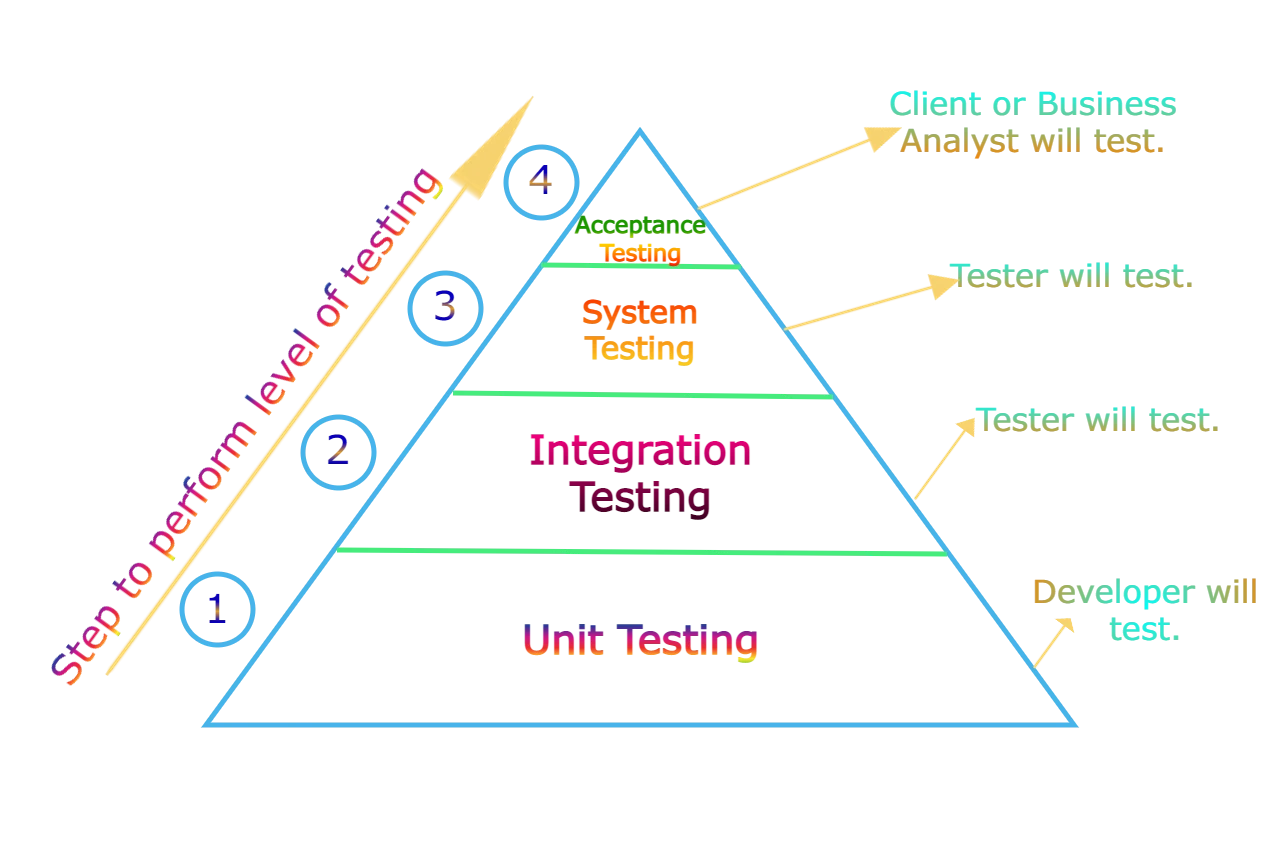Levels of Testing
Software testing is an essential aspect of software development, as it ensures that the software application meets the desired quality standards. In software testing, there are different levels of testing, each with its specific objectives and methods. In this tutorial, we will discuss the various levels of testing in detail.

Levels of Testing in details
The following section provides an overview of the different levels of testing, each with its specific objectives and methods, that are implemented to ensure the software application meets the desired quality standards. Let's take a closer look at each of these levels of testing.
1. Unit Testing
Unit testing is the first Levels of Testing and is performed on individual modules or units of code to ensure that each unit is functioning correctly as per the design. This testing is usually performed by developers, and it involves testing individual code units to ensure their functionality, accuracy, and completeness. Unit testing helps identify defects early in the development process, making it easier and less expensive to fix them.
2. Integration Testing
Integration testing is the process of combining individual units or modules of code to form a complete system. The objective of integration testing is to ensure that the system's components function correctly together and can communicate with each other as intended. Integration testing helps identify defects that may arise due to the interaction between different system components.
3. System Testing
System testing is the process of testing the complete system as a whole. This testing involves checking the system's functionality, performance, and behavior concerning the specified requirements. This testing is performed in a test environment that mimics the actual production environment. System testing helps identify defects that may arise due to the interaction between different system components and ensure that the system meets the specified requirements.
4. Acceptance Testing
Acceptance testing is performed to validate whether the software application meets the customer's requirements and expectations. This testing is usually performed by the customer or end-user to ensure that the system is ready for release. Acceptance testing helps identify defects that may affect the system's usability and ensures that the system meets the customer's requirements and expectations.
- In general, there are
fourlevels of testing: unit testing, integration testing, system testing, and acceptance testing. These are performed in that order, starting with testing individual units or modules of code and ending with testing the complete system to ensure it meets the customer's requirements. - However, in addition to these
fourlevels, further testing can be performed after acceptance testing, such as regression testing, performance testing, security testing, alpha testing, and beta testing. These tests help to identify and resolve any defects or problems with the software application before and after its release. - In general, software testing follows a sequential process, where the first Levels of Testing is unit testing, followed by integration testing and system testing. However, after acceptance testing, additional testing such as regression testing, performance testing, security testing, alpha testing, and beta testing may be performed depending on the software application's requirements and complexity. Beta testing is typically the final Levels of Testing performed before the software is released to the public.
5. Regression Testing
Regression testing is performed to ensure that changes made to the software application do not affect the existing functionality of the system. It involves re-testing the entire application or a subset of it after any changes have been made. Regression testing helps identify defects that may arise due to changes made to the system and ensures that the system's existing functionality remains intact.
6. Performance Testing
Performance testing is performed to determine the system's ability to perform under varying loads and stress levels. This testing is used to ensure that the system can handle the expected user load and function correctly under different conditions. Performance testing helps identify defects that may affect the system's performance and ensures that the system can handle the expected user load.
7. Security Testing
Security testing is performed to ensure that the system's data is protected against unauthorized access, manipulation, and theft. This testing involves identifying vulnerabilities in the system and implementing measures to ensure the system's security. Security testing helps identify defects that may affect the system's security and ensures that the system's data is protected.
8. Alpha Testing
Alpha testing is performed to identify defects and problems with the software application before it is released to the public. This testing is usually performed by the development team or a selected group of end-users. Alpha testing helps identify defects and problems with the software application before it is released to the public.
9. Beta Testing
Beta testing is performed to identify defects and problems with the software application after it has been released to a limited audience. This testing is usually performed by a group of end-users who provide feedback to the development team.
In conclusion, understanding the different levels of testing is essential to ensure that the software application meets the desired quality standards. Each Levels of Testing has its specific objectives and methods, and the choice of testing levels depends on the software application's requirements and complexity.
 Youtube Link
Youtube Link